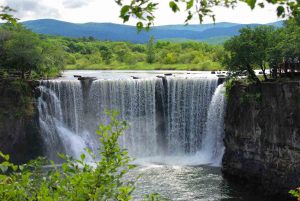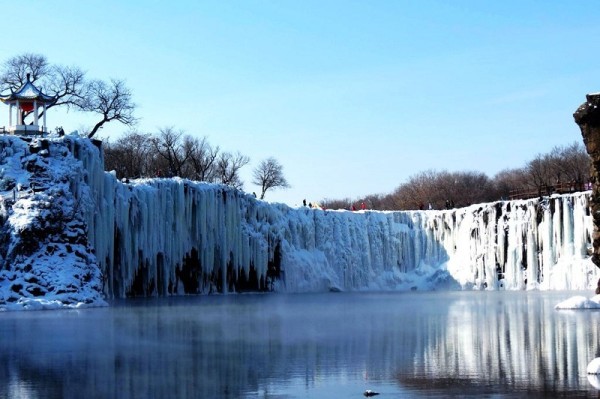Located deep within the Wanda Mountains of Heilongjiang province, Jingpo Lake is a shimmering gem among the ragged volcanic rocks. Its crystal clear pools, rushing waterfalls, dense forests, and volcanic landforms create a spectacular tableau, earning it the title of UNESCO Global Geopark in 2006. The name “Jingpo Lake” literally translates to mean “Mirror Lake” and is derived from a local legend, which states that it was once a mirror dropped from heaven by a goddess. While most people would incur seven years of bad luck, the goddess’ mirror instead hit the earth and transformed into a beautiful lake!
Historically speaking, the lake was actually formed about 4,700 to 8,300 years ago, when a series of five volcanic eruptions released magma that eventually cooled and dammed the upper reaches of the Mudan River. This has resulted in a somewhat unusual shape since, rather than being round or oval like a typical lake, Jingpo Lake maintains the original shape of its watercourse and resembles an S-shaped ribbon. It is divided into four parts, Upper Lake, North Lake, Middle Lake, and South Lake, and is often referred to as the “100-Li Long Lake” because it stretches for a distance of approximately 100 li[1] (48 km or 30 mi).
Its turquoise-hued waters, speckled with freshwater coral, harbour over 40 species of fish. Every year, from December through to March, the Jingpo Lake Ice Fishing Festival offers visitors the opportunity to attend a worshipping ceremony for the Lord of the Lake, test their skill at fishing, and sample some of the finest local fish dishes. With such tempting treats on offer, any seafood lover should make sure to catch this festival!
 At the lake’s northern end, you’ll find the scenic area’s star attraction: Diaoshuilou Waterfall. Dropping for over 20 metres (66 ft.) and with a width of over 40 metres (130 ft.), it is one of the widest waterfalls in Asia and is said to resemble Niagara Falls in its grandeur. If that wasn’t impressive enough, every day the park holds two performances where a professional diver jumps from the top of the waterfall and deftly dives into the 60-metre (200 ft.) deep pool below.
At the lake’s northern end, you’ll find the scenic area’s star attraction: Diaoshuilou Waterfall. Dropping for over 20 metres (66 ft.) and with a width of over 40 metres (130 ft.), it is one of the widest waterfalls in Asia and is said to resemble Niagara Falls in its grandeur. If that wasn’t impressive enough, every day the park holds two performances where a professional diver jumps from the top of the waterfall and deftly dives into the 60-metre (200 ft.) deep pool below.
Towards the northwest of the lake, twelve volcanic craters are scattered among the dense forests of the scenic area. These lush forests act as habitats for over 50 species of wild mammal and more than 500 kinds of wild bird. Under these volcanic plateaus, you’ll find spectacularly eerie lava tunnels, some of which are over 10,000 metres (32,800 ft.) long. They are some of the largest and most intact lava tunnels in China, earning the region the nickname the “Underground Forest”.
Yet natural delights aren’t the only thing on the menu at Jingpo Lake. The area is also home to numerous historical sites from the Korean Balhae Kingdom (698–926). During the Tang Dynasty (618-907), the Balhae Kingdom ruled over large parts of northeast China and, in many ways, sought to imitate the highly successful Tang regime. Shanjing Longquanfu, an ancient imperial city located just 20 kilometres (12 mi) north of Jingpo Lake, was designed based on the pattern of Chang’an (modern-day Xi’an), the Tang imperial capital. The city walls and main buildings of the imperial palaces have been preserved intact, and remain a popular tourist destination.
The 1,200-year-old Xinglong Temple, another relic of the Balhae Kingdom, is now used to house valuable cultural artefacts found in the region. The most famous of these is the Stone Lamppost, a Buddhist stone carving that exemplifies the sculptural style of both the Tang Dynasty and the Balhae Kingdom. Aside from its natural beauty and historical significance, Jingpo Lake has a space-age claim to fame! A large surface body of liquid hydrocarbons on Titan, the largest moon orbiting planet Saturn, was named Jingpo Lacus in its honour. In other words, you could say that this lake has astronomical appeal!
[1] Li: A unit of distance used in China that roughly equates to 500 metres (1,640 ft.).
